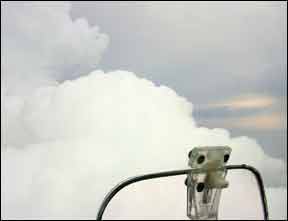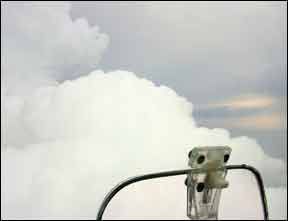Those who successfully earn the private certificate or an instrument rating are told many things along the way. Among them is their hard-fought goal is a license to learn; they should carefully consider the first few hours they spend aloft without someone in the right seat; they should consider setting something called “personal minimums” for themselves. All of these suggestions can be helpful to someone who hasnt fully considered all the responsibilities and freedoms their new certificate or rating affords. Meanwhile, some would suggest the best advice a new pilot could 288 receive is “just go fly.” Personal minimums, of course, generally are a set of conditions-not unlike the basic VFR weather minimums or the ceiling and visibility requirements for an instrument approach, but also involving other operational considerations-beyond which a pilot vows not to fly. The idea is-at least in the first few flight hours after getting the new certificate or rating-the fresh-out-of-training pilot needs to avoid marginal VFR weather and really low IFR conditions because he or she isnt experienced-seasoned perhaps is a better word-to handle them. That may be. But perhaps a foundation in risk assessment, along with well-honed piloting skills-is a better alternative? Training Issues Several concepts are involved with this whole idea of personal minimums and/or taking it easy until some hours and experience are racked up. Perhaps first among them is the idea someone with a new certificate needs to gain additional experience before he or she can fully exercise its privileges. In response, we might suggest the new certificate isnt valid. If a pilot with a fresh rating or certificate cant manipulate the controls and exercise the judgment required to safely and reliably operate an aircraft in the regime for which he or she has been trained, then perhaps the certificate or rating shouldnt have been granted. Accepting such reasoning suggests something is lacking from the pilots training. In fact, many new instrument ratings are handed out without the pilot actually having seen the inside of a cloud, shot an approach to minimums in for-real-rain, wind, turbulence, fog-weather. Many such pilots are based in good-weather areas and a lot of that is understandable. Certainly, they should get themselves to an area with less-hospitable weather and obtain a few hours of dual in the clag before venturing out on their own to distant destinations. At the same time, a brand-new private pilot who has only flown on days when the weather is clear and a million probably wont have a clue what to do when a cloud layer moves in or evening haze, perhaps combined with a sunsets glare, make spotting traffic or their intended destination almost impossible. While there are exceptions-the aforementioned pilots who trained only in good-weather areas, for example-we would suggest such a pilots instructors and flight training organization have not fulfilled all their responsibilities. True, not every instructor or flight school can prepare a pilot for every eventuality theyll encounter in their flying careers. Thats not what were saying. Instead, a pilots training should also teach them how to evaluate various conditions-weather perhaps being chief among them-but also the many other factors inherent in safe, reliable use of personal airplanes. Hard And Fast? By now, the reader probably has surmised we have a fundamental problem with personal minimums. We do. That said, if personal minimums are your cup of tea, refer to the sidebar on page 21 for some ideas on how to set them and what they might look like. Meanwhile, the first problem we have with personal minimums has nothing to do with setting them. If you never want to fly in less than 3000-and-five, thats fine with us (in fact, we might feel the same way under many circumstances). Rather, our problem involves deciding when and under what circumstances personal minimums can be broken. If the answer is “never,” how will we decide weve gained enough exposure, experience and flight hours to relax some of those minimums? If “never” remains the answer, the pilot also is accepting what we believe are artificial constraints on the ways and circumstances under which he or she can use personal aircraft. Be that as it may, the question remains: How to decide whether to relax or eliminate personal minimums altogether? We might suggest-if establishing personal minimums are a necessity-to also establish a training and/or experience regimen wherein the “new” pilot also seeks to acquire certain specific experience over a fixed number of flight hours. Such a regimen might include, for example, getting an instructor and/or appropriately rated and experienced safety pilot and shooting some for-real ILS approaches to, say, 500-and-one. Then, we go out and fly a few trips when we deliberately seek out IMC and remain in it for as much of the flight as possible. If, for example, we committed to this kind of “envelope expansion” over, say, our next 50 hours and year of flying, we would have set a reasonably attainable goal, with fixed metrics we can easily monitor and verify. Not only will doing so demonstrate such operations dont require the skill and derring-do of Orville and Wilbur, well also gain valuable exposure to what that kind of weather looks and feels like. If, after accomplishing these goals, we still fear low IMC, for example, then well need to make other decisions. They might include even more training, better equipment or-face facts-deciding youre simply not cut out for instrument flying. Risk-Management Training Of course, the idea of establishing personal minimums isnt a new one. What is new, however, is the emphasis the FAA and various flight training organizations recently have placed on risk management concepts and their application to pilot decision making. We think thats a very good thing. In fact, developing and implementing personal minimums is just one aspect of an overall risk-management approach to your aeronautical decision making. For example, there are many factors you may wish to consider in evaluating whether to make a proposed flight than those discussed in this article. Ask yourself: Is it really the smartest decision you can make to put in a full day at the office, slog through rush-hour traffic and launch on a four-hour night flight just to give a 30-minute presentation the next morning? Alternatively, wed strongly suggest, for example, leaving work ahead of the evening rush and planning on a more leisurely and less hectic afternoon-you could be in a hurry and miss something important on the preflight. Likewise, you may not be feeling well-summertime allergies, for example, or some other, non-work-related stressors. Whether we acknowledge it or not, everyday complications can drain us of the energy to make and implement sound decisions. Instead, we go with the flow until the flow has us shooting an ILS to minimums without enough fuel to find an alternate. Of course, any illness, fatigue or other physical/emotional problem should keep us out of the cockpit, at least temporarily. Once the issue is resolved, however, it may have been some time since we flew. Thats always a good time to get some dual before striking out on or own again. What To Do? No, were not a fan of personal minimums, but they may be something that works for you. If so, evaluate your experience, along with the kind of flying you want to do, then develop a plan to implement your newfound minimums-as well as one to determine if and when theyre no longer needed-and get to work on obtaining the experience and training necessary to confidently confront the types of operations in which you feel deficient. If, like us, youd rather have or develop the ability to evaluate each flight on its merits, along with your readiness to tackle its challenges, you still may need a plan to get there. It likely will include a cooperative instructor or safety pilot/mentor, some planning and studying allowing you to fill in whatever gaps in your knowledge may still exist and the dedication/perseverance necessary to fly with the confidence and skill for which you got into this flying “thing” in the first place. At the end of the day, though, one piece of advice discussed at the beginning of this article remains valid: Just go fly. There simply is no substitute for experience. Along the way, youll gain the insights and skills necessary to evaluate weather, the aircraft, the operation and your own capabilities. Youll come out the other end a better, safer, more relaxed pilot.




